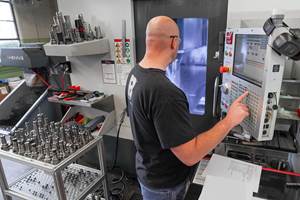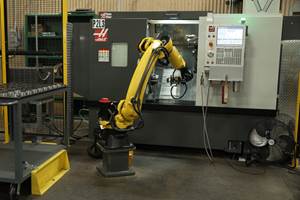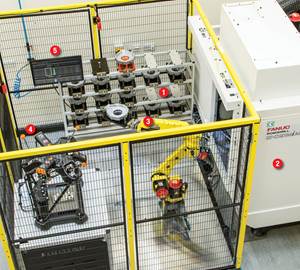What Is the Next Big Thing for Your Shop? Three Top Shops Winners Reply
All their replies pointed to automation. One also sees additive manufacturing. Watch video from the Top Shops Conference.
Share






In a Q&A session at 91ÊÓƵÍøÕ¾ÎÛ’s Top Shops Conference, representatives of three Top Shops Honors Program winners—Land Sea Air Manufacturing, Richards Industries and X-L Machine Co.—all were asked, “What is the next big thing for your shop?” The video clip captures their answers.
Transcript:
Peter Zelinski, 91ÊÓƵÍøÕ¾ÎÛ
So, the gentleman didn't have a microphone, so to paraphrase his question, or to quote it literally, “What's the next big thing?” [What is] an idea or a technology that you guys are really looking at as potentially very impactful?
Carl Livesay, Land Sea Air Manufacturing
That's a great question. For us, it's robotics. And it’s eliminating machine tenders. Okay? And I don't mean eliminating as in getting rid of them. I mean, as in escalating them up, turning them into machinists. So, machine tending is typically, on its best day in our shop, it is a semi-skilled responsibility. In most cases, it's unskilled. So, we're actually looking—in fact, I was talking to the guys over at FANUC yesterday, and I forget the gentleman's name that's doing a presentation here today at 3. We're looking to replace the non-value-added activity of loading and unloading the machine with a task robot that can be moved from machining center to machining center and set up in a couple of hours to do the load and unload. And we think that's…. Labor rates are getting up there, right? And you know, there's a move afoot at least in Maryland to make the minimum wage like $15 an hour. Now, our machinists are—I'll say our semi-skilled folks are $15 an hour, but if I'm going to pay for machine tenders that's a substantially lower cost, lower responsibility. I can rent (forget about buy for the time being)—I can rent a robot for $7.50 an hour. So yeah, I'm on that, like a big dog.
Chris Orlowski, X-L Machine Co.
For X-L Machine, the same thing. Industry 4.0, it’s the hot topic and that's exactly what we're looking at doing for some of our continuous work cells. Something that can and will run by itself because we cannot hire anybody, not even as general labor where we're at. So we're continuously working with high schools and getting students to come into our apprenticeship program, but those guys are not going to be the ones that are going to run machines, right? Or operate machines. We have to get a way of operating machines without having the problem of somebody calling in sick, without having the problem of just misloads consistently. That's our number-one internal scrap rate is misloads, and to have something with consistency and be able to read the part and then the part goes into the machine and then you have a robot of some sort that can transfer from machine to the next machine, and being able to integrate quality in there as well [via] probing and CMMs is going to be a huge feat. So that's our challenge.
Bill Metz, Richards Industries
As far as we're concerned at Richards, we are looking at robotics, but we are very high-mix, low-volume, but I do believe that there will be a time that it will be justified. Robots are obviously becoming smarter and smarter and more and more flexible. And we have the same problem as everybody else, hiring people. So that's something we're constantly looking for. I don't think we're ready yet. Machine data collection, obviously is key for what we're doing.
And then we’re also dabbling in 3D additive manufacturing. Why I say “dabbling:” We got a little tabletop unit, but it's amazing how we've used that for some pretty simple inspection fixtures—things like that. So, I think our next step will be expand on 3D additive manufacturing, probably still in the plastics area, but then you've got an opportunity with some of the low-volume stuff that we do, [including] developing patterns through 3D printing that you can then use for castings and eliminate the lead time for patterns in molds as well as the costs associated with those. So those are the things that I think are continuing to drive change.
Related Content
3 Ways Artificial Intelligence Will Revolutionize Machine Shops
AI will become a tool to increase productivity in the same way that robotics has.
Read MoreMedical Shop Performs Lights-Out Production in Five-Axes
Moving to five-axis machining enabled this shop to dramatically reduce setup time and increase lights-out capacity, but success relied on the right combination of workholding and automation.
Read MoreWhich Approach to Automation Fits Your CNC Machine Tool?
Choosing the right automation to pair with a CNC machine tool cell means weighing various factors, as this fabrication business has learned well.
Read More5 Stages of a Closed-Loop CNC Machining Cell
Controlling variability in a closed-loop manufacturing process requires inspection data collected before, during and immediately after machining — and a means to act on that data in real time. Here’s one system that accomplishes this.
Read MoreRead Next
Machine Shop MBA
Making Chips and 91ÊÓƵÍøÕ¾ÎÛ are teaming up for a new podcast series called Machine Shop MBA—designed to help manufacturers measure their success against the industry’s best. Through the lens of the Top Shops benchmarking program, the series explores the KPIs that set high-performing shops apart, from machine utilization and first-pass yield to employee engagement and revenue per employee.
Read MoreLast Chance! 2025 Top Shops Benchmarking Survey Still Open Through April 30
Don’t miss out! 91ÊÓƵÍøÕ¾ÎÛ's Top Shops Benchmarking Survey is still open — but not for long. This is your last chance to a receive free, customized benchmarking report that includes actionable feedback across several shopfloor and business metrics.
Read MoreAMRs Are Moving Into Manufacturing: 4 Considerations for Implementation
AMRs can provide a flexible, easy-to-use automation platform so long as manufacturers choose a suitable task and prepare their facilities.
Read More






















